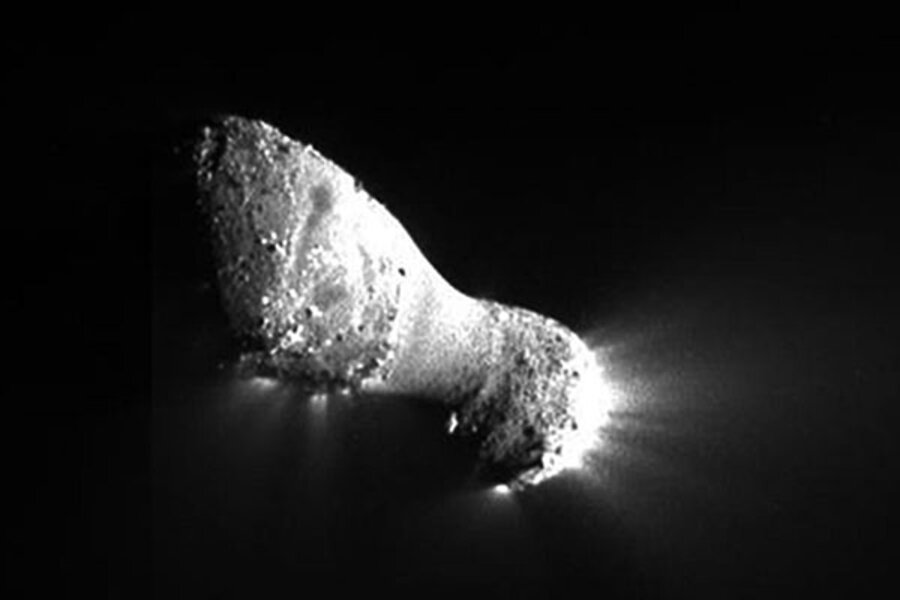Where did Earth's water come from? Comet Hartley 2 offers new clues.
Loading...
For years, astronomers have been drafting a Kipling-like "Just So" story one might call "How the Earth Got Its Oceans." But they have had a tough time figuring out how to divvy up the credit between two potential sources – comets and asteroids.
Now, it seems, comets may have played a more significant role in drenching the third rock from the sun that previously thought.
Comet 103P/Hartley 2, which made its closest approach to the sun last October, contains water with virtually the same chemical signatures as water in the oceans, according to a study published Thursday in the journal Nature.
That signature shows up in the relative abundance of two forms of water: a typical water molecule, H2O; and a much rarer type known as heavy water, in which one of the two hydrogen atoms has a neutron in its nucleus and the other doesn't.
But the findings raise new questions. The proportion of heavy water in the vapor spewed by Hartley 2 is much lower than theory says it should be, given where astronomers believe the comet formed. It's also lower than the proportion astronomers have measured in other comets so far.
"To me, this changes the problem," says Edwin Bergin, a University of Michigan astronomer and member of the team reporting the results.
Questions of the source for Earth's oceans are giving way to trying to figure out why comets have these differences in their water's chemistry and what that might imply for the formation and evolution of the solar system.
"That wasn't yesterday's problem," he acknowledges with a chuckle.
The team, led by Paul Hartogh with the Max Planck Institute for Solar System Research in Katlenburg-Lindau, Germany, used the European Space Agency's Herschel Space Observatory to analyze Hartley 2's halo, or coma, when the comet passed within 11 million miles of Earth shortly before its closest approach to the sun last year.
Much of the significance of Hartley 2 is where it comes from – a broad swath of frigid objects orbiting the sun beyond Neptune, called the Kuiper Belt.
Until now, scientists have only been able to measure the chemical signatures of comets from the Oort Cloud – a halo of comets much farther away from the sun at a distance of more than 5,000 astronomical units. (The Earth is 1 AU from the sun.)
These comets are thought to have formed just beyond the outer edge of today's asteroid belt between Mars and Jupiter, where sunlight is too feeble to thaw water ice. As Jupiter and other gas giant planets grew, their gravity flung these planetesimals deeper into space to form the Oort Cloud, researchers say.
From there, the comets might have slammed into Earth, delivering water and other volatiles, such as nitrogen.
But measurements of water in six Oort Cloud comets such as Hyakutake in 1996, or former Oort Cloud comets, such as Halley's Comet in 1986, showed twice the concentration of heavy water to normal water as did Earth's seawater.
Comets' stock plunged as cosmic tankers. Researchers concluded that comets could have contributed no more than about 10 percent of the oceans' water.
That would leave the bulk of the delivery to asteroids, which also contain water, notes Daruisz Lis, an astronomer at the California Institute of Technology and another member of the team reporting the results.
With Hartley 2, the pendulum may be swinging back in the comets' direction. But therein lie additional puzzles, Dr. Lis continues.
The reason: Hartley 2's composition doesn't appear to fit its birthplace.
Based on scientist's current understanding of cosmic chemistry, the deeper the chill, the higher the relative abundance of heavy water compared with H2O in ices. The warmer it is, the lower the abundance.
That would imply that the comets that formed closest to the sun – the Oort Cloud comets – should have lower abundances of heavy water in their ices than comets that formed farther out in the Kuiper Belt.
Yet in Hartley 2, a Kuiper Belt native, astronomers have a comet with less heavy water in its ices than is present in comets that formed closer to the sun.
**Hartley 2 is only one example, Lis acknowledges. It's unclear how representative the comet is of its relatives in the Kuiper Belt, called the Jupiter Family.
If it is representative, it could mean one of two things.
Scientists may need to revamp their models of heavy-water distribution in the disk of dust and gas surrounding the young sun. Or Hartley 2 could be a sign that objects early in the solar system's evolution were moving toward and away from the sun with some regularity as the giant planets in particular migrated from their birthplaces to their current orbits.
As for cometary collisions that would have delivered the water? Lis says they would have to have been very gentle.
"If you smash a comet into proto-Earth at very high velocity, there's a pretty good chance that the debris will be ejected back into space. Nothing would stay," he says. This would have to be true for asteroids as well as comets delivering water, he says.
An early Earth watered by cometary kisses?





